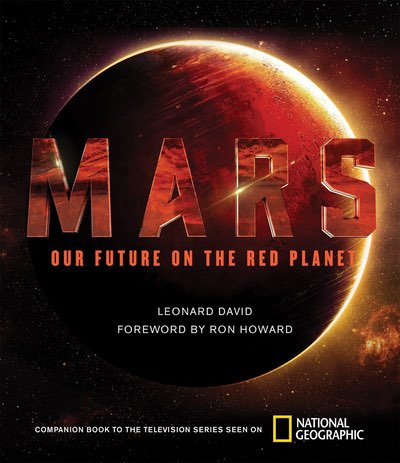Review: Mars: Our Future on the Red Planetby Jeff Foust
|
 A fictional Mars habitat set up in lower Manhattan to publicize the upcoming television “global event” by National Geographic. (credit: J. Foust) |
That publicity, though, has been strangely uneven. While National Geographic was building simulated Mars habitats and sending out flight jackets as pricey giveaways, it took several weeks for them to provide this publication with a review copy of Mars: Our Future on the Red Planet, a companion book to the upcoming series. (Our invitation to a premiere screening must have gotten lost in the mail.) Fortunately, they did come through, and it’s a good thing: the book, by veteran space journalist Leonard David, is a fine guide to the efforts regarding, and the challenges facing, sending humans to Mars.
| David’s dry wit makes it way into the book’s discussion of the challenges of landing on Mars: “Toppling over in your spaceship on landing is a profoundly bad day.” |
While the book is tied to the television series, it’s a tenuous link: the only way from reading the book that you would know there was a series was from the book’s foreword by Ron Howard, one of the show’s producers, and by a few stills from the dramatized scenes in the show inconspicuously scattered across its pages. Otherwise, the book stands on its own as a review of the issues facing plans to send humans to the Red Planet.
The book covers many of the issues associated with human exploration of Mars. They include the technical issues of getting to and landing on Mars, the scientific questions of where to go and the search for life, and the political difficulties of forging international support and bringing in the private sector. (While SpaceX’s interest in Mars is included in the book, Elon Musk’s Mars mission architecture, announced just a month and a half ago, was far too late to make it into print.) A final chapter examines the sociological implications of having a permanent human presence on Mars, including people who live their entire lives there.
As you’d expect from a large-format book published by National Geographic, Mars: Our Future on the Red Planet is lavishly illustrated with a mix of actual images of Martian exploration and illustrations of proposals for future missions. Each chapter also profiles a couple “heroes” of Mars exploration, from JPL Mars mission manager Rob Manning to policy expert John Logsdon. And David’s dry wit makes it way into the book’s discussion of the challenges of landing on Mars: “Toppling over in your spaceship on landing is a profoundly bad day.”
If you’re a regular reader of publications like this, then a lot of the issues discussed in Mars: Our Future on the Red Planet will be familiar. The audience for the book, though, is instead that group of people who, perhaps, got interested in the concept of human Mars exploration by the series and want to examine the issues in greater detail than a hybrid miniseries/documentary can explore. They may find their interest in Mars exploration heightened by the book, despite all the obstacles that such missions face. Or they might decide they want to stick around on Earth, as challenging as life might seem here.
